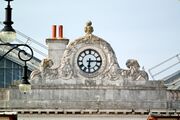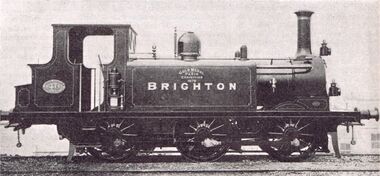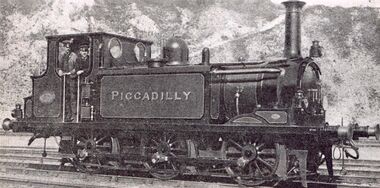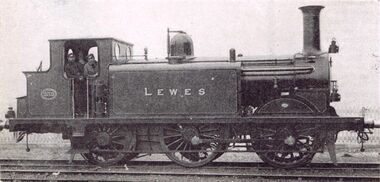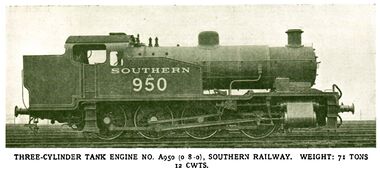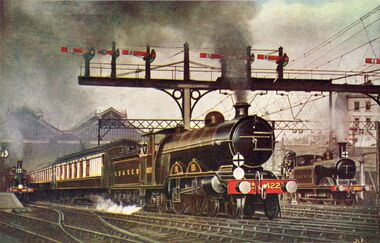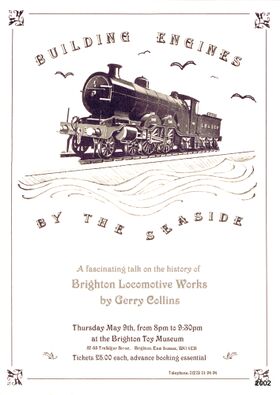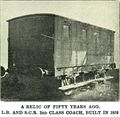Category:Brighton Locomotive Works
| Brighton Station |
|---|
Brighton Locomotive Works |
|
Station | History | CabRoad | GoodsTunnel | LocoWorks | Greenway | ToyMuseum |
0-6-0 Terrier-Class locomotive LBSCR 40 "Brighton", built at Brighton Locomotive Works in 1878 [image info]
0-6-0 Terrier-Class locomotive LBSCR 41 "Piccadilly", built at Brighton Locomotive Works in 1877. [image info]
0-4-2 LBSCR D1 Class locomotive 232, Lewes, built at Brighton Works in 1884 [image info]
0-8-0 tank locomotive A950, built at Brighton Works in 1929 [image info]
Two Brighton Works locos leaving Victoria Station [image info]
"Building Engines by the Seaside", lecture by Gerry Collins, 2002 [image info]
Brighton Locomotive Works (or just, Brighton Works) was one of Britain's earliest steam locomotive manufacturing facilities, and is reckoned to have been responsible for producing over twelve hundred engines, including the E2 Class second-series design used in the illustrations for "Thomas the Tank Engine".
The site of the works can be seen if you exit the Museum, turn left, and look at the newer buildings on Trafalgar Street to the immediate left of the Museum. These occupy a space that was previously railways sidings and the engine works.
As a nod to the site's heritage, many of the roads and walkways in the area are named after railway engineers and designers, or have other railway associations.
Brighton Locomotive Works had a difficult history, due to the geographical awkwardness of a restricted site cut into the side of a hill, which made lack of space a constant problem.
1847-1869: John Craven
When John Chester Craven took over as Locomotive Superintendent in 1847, his reign, while not exactly disastrous, created acute long-term problems for the Works. Craven's natural inclination, as with many of the early locomotive engineers, was to be a "tinkerer" ... to treat each new locomotive or loco batch as an exciting opportunity for improvement or experimentation, with the result that the number of official locomotive classes that the Works had to support was supposed to be greater than seventy. Trying to maintain servicing knowledge and spares for more than seventy loco types must have been a nightmare. In March 1853, locomotive No. 10 exploded at the beginning of the shift, killing the three people who in the cab. The locomotive had recently been serviced, and the enquiry found that the loco had been so extensively patched and modified that there was little possibility of finding out what had really happened, and while Craven wasn't blamed, questions were probably asked about how the Works had been run under his leadership.
Craven's biggest achievement seems to have been persuading the civic authorities to allow him to remove the hill of chalk rubble on the lower side of the line that had been created when the hillside had been cut into to create space for the station and the main line. While the town was originally against this, they relented when Craven said that his alternative was to remove the works (and its jobs) to a more convenient site further up the line. Completely removing the chalk hill, a little at a time, took many years ... but once it had gone, Craven's successor was able to put the cleared space to good use.
It's perhaps notable that while his successors have roads on the old Works site named after them: Stroudley Road and Billinton Way – nobody seems to have named anything after Craven.
1870-1889: The Stroudley Years
William Stroudley (1833-1889) took over the Locomotive Engineer position after Craven retired, and stayed in post until his death in December 1889.
Stroudley immediately set about a process of simplifying and standardising the stock of locomotives and locomotive parts, reducing the range to six classes with as many interchangeable parts as possible. This didn't just reduce the space requirements for storing spare parts, spares could now be more produced more proactively knowing that they would definitely be used, and the easier supply of spares meant that more repairs could be made with drop-in replacements available from stock, speeding up turnaround times and reducing the space needed for locos waiting to be repaired.
Stroudley also encouraged the specialisation of skills – with standardisation, instead of making one spare part for the stores, one could have an identical batch made, ideally by the same person who made the last batch, and who (hopefully) knew that part better than the other people in the Works. Standardisation didn't just reduce costs and space and time, it could also improve quality.
1890-1904: The Billinton Years
Billinton took over in January 1890, almost immediately after Stroudley's death.
Billinton was extremely capable and had a wide range of experience at different employers, including a spell of perhaps four years as Stroudley's assistant at the LB&SCR from 1870, followed by a similar role at the Midland Railway. This meant that Billinton already had an in-depth understanding of the Brighton Works site and company culture, but also had first-hand knowledge of how things worked at other railways.
In the museum
The museum foyer has a display area devoted to Brighton Locomotive Works, including paintings.
External links
Subcategories
This category has the following 5 subcategories, out of 5 total.
B
- Brighton Greenway (1 P, 8 F)
E
- E. Burrows (3 P, 3 F)
I
- Isetta bubble-cars (6 P, 1 F)
T
- Terrier Class locomotives (2 F)
Pages in category ‘Brighton Locomotive Works’
The following 24 pages are in this category, out of 24 total.
B
- Beachy Head locomotive (gauge 0)
- Bessemer locomotive LBSC 213 (gauge 0)
- Billington E2 tank locomotive 104 (Hornby R353)
- BMW Isetta bubble-car, bright red, LTR 145 (Spot-On 118)
- BMW Isetta bubble-car, dark blue, JPO 113 (Spot-On 118)
- BMW Isetta bubble-car, dark red, LXQ 216 (Spot-On 118)
- BMW Isetta bubble-car, green, JPO 113 (Spot-On 118)
- BMW Isetta bubble-car, light mauve (Spot-On 118)
- BMW Isetta bubble-car, yellow, CMO 118 (Spot-On 118)
- Brighton locomotives
- Budleigh Salterton locomotive nameplate
L
S
Media in category ‘Brighton Locomotive Works’
The following 38 files are in this category, out of 38 total.
- Another view of the Paint Shop, Brighton Works (TRM 1903-04).jpg 3,000 × 2,146; 1.36 MB
- Belgravia, LBSCR 201, 2-4-0 locomotive (TRM 1903-04).jpg 3,000 × 1,534; 937 KB
- Boiler Shop, Brighton Works (TRM 1903-04).jpg 3,000 × 2,007; 1.44 MB
- Brighton Greenway, April 2016.jpg 2,000 × 1,334; 1.89 MB
- Brighton Works and LBSCR, Billinton interview (TRM 1903).jpg 2,200 × 1,442; 656 KB
- Brighton, Terrier Class locomotive LBSCR 40 (RWW 1935).jpg 3,000 × 1,391; 2.67 MB
- Building Engines by the Seaside, lecture by Gerry Collins (2002-05-09).jpg 1,416 × 2,000; 408 KB
- Bulleid Leader.jpg 700 × 280; 47 KB
- Carriage Erecting Shop, Brighton Works (TRM 1903-04).jpg 3,000 × 2,323; 1.96 MB
- Dieppe, LBSCR 490, 2-2-2 locomotive (TRM 1903-04).jpg 3,000 × 1,245; 691 KB
- Duchess of Fife, LBSCR 43 (TRM 1903-04).jpg 3,000 × 1,990; 1.29 MB
- Erecting Shop, Brighton Works (TRM 1903-04).jpg 3,000 × 2,037; 1.42 MB
- Fairlight, LBSCR 331, 0-2-2 locomotive (TRM 1903-04).jpg 2,979 × 2,121; 552 KB
- Gladstone loco 214 (Miller Swan).jpg 1,024 × 574; 389 KB
- Hickstead, LBSCR 571, 0-6-2 tank locomotive (TRM 1903-04).jpg 3,000 × 1,890; 1.37 MB
- Hurst Green, LBSCR 465, 0-6-2 tank locomotive (TRM 1903-04).jpg 3,000 × 1,496; 1.08 MB
- Jenny Lind, 3.5-inch gauge steam model (Bill Hinchley).jpg 2,000 × 1,334; 514 KB
- Leader-Class steam locomotive model.jpg 1,024 × 603; 333 KB
- Lewes, LBSCR D1-Class locomotive 232 (RWW 1935).jpg 3,000 × 1,435; 2.72 MB
- Locomotive and Carriage Painting Shop, Brighton (TRM 1903-04).jpg 3,000 × 2,253; 1.6 MB
- Locomotive tools, sculptures, Brighton Greenway.jpg 2,000 × 1,334; 1.73 MB
- Märklin Stephenson gauge 1 locomotive.jpg 640 × 480; 187 KB
- Piccadilly, Terrier Class locomotive (RWW 1935).jpg 3,000 × 1,488; 3.09 MB
- Pillars belonging to the old Brighton Locomotive Works (Brighton Greenway).jpg 1,800 × 1,352; 1.58 MB
- Seaford, LBSCR 282, 2-2-2 locomotive (TRM 1903-04).jpg 3,000 × 1,703; 1.12 MB
- Southern A950 tank locomotive (WBoR 14ed).jpg 3,000 × 1,358; 2.05 MB
- Southern Belle leaving Victoria Station, postcard (F Moore).jpg 2,500 × 1,600; 3.3 MB
- Standard 48ft bogie brake van, Brighton Works (TRM 1903-04).jpg 1,800 × 1,062; 471 KB
- Stephenson 329 locomotive, gauge 1 (Marklin).jpg 1,200 × 900; 561 KB
- Stephenson Tank Locomotive Southern 329, 4-6-4, Märklin TK1020 (MarklinCRH ~1925).jpg 2,104 × 1,115; 962 KB
- Tank locomotive SR 329 Stephenson, Märklin MTK 1020 1021 (Bonds 1932-2ed).jpg 2,500 × 789; 812 KB
- The Boiler Shop, Brighton Locomotive Works (E Burrows ~1955).jpg 1,200 × 976; 854 KB
- The Erecting Shop, Brighton Locomotive Works (E Burrows ~1955).jpg 1,200 × 947; 823 KB
- The Foundry, Brighton Locomotive Works (E Burrows ~1955).jpg 1,200 × 969; 625 KB
- Third Class Coach, LBSCR, built 1852 (TRM 1903-04).jpg 1,800 × 1,752; 791 KB
- Tri-ang Wrenn Model Railways, catalogue front cover (TWCat 1971).jpg 1,424 × 2,000; 554 KB
- Truscott, LBSCR 364, 0-4-4 tank locomotive (TRM 1903-04).jpg 3,000 × 1,707; 1.4 MB
- Turning and Machine Shop, Brighton Works (TRM 1903-04).jpg 3,000 × 2,280; 1.69 MB

